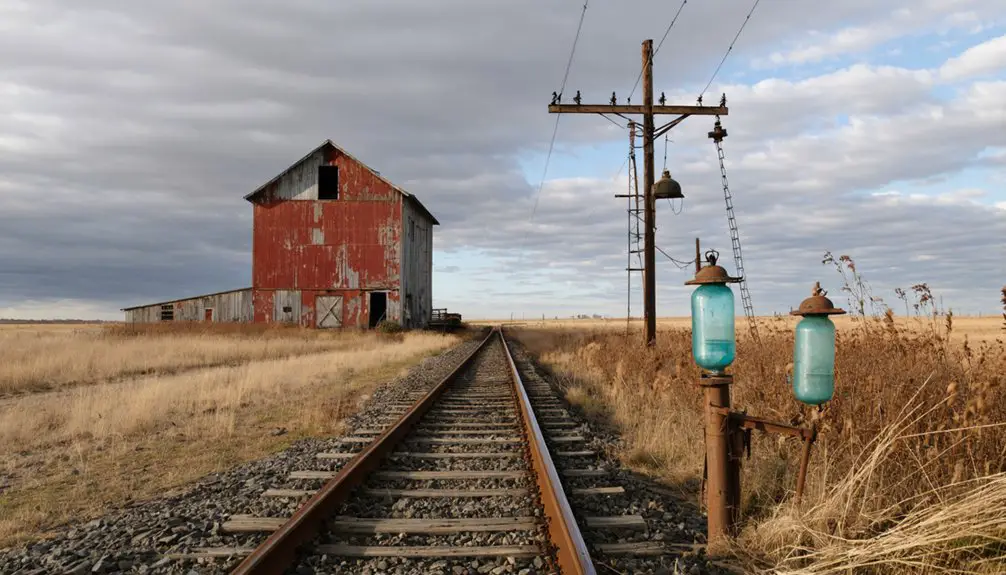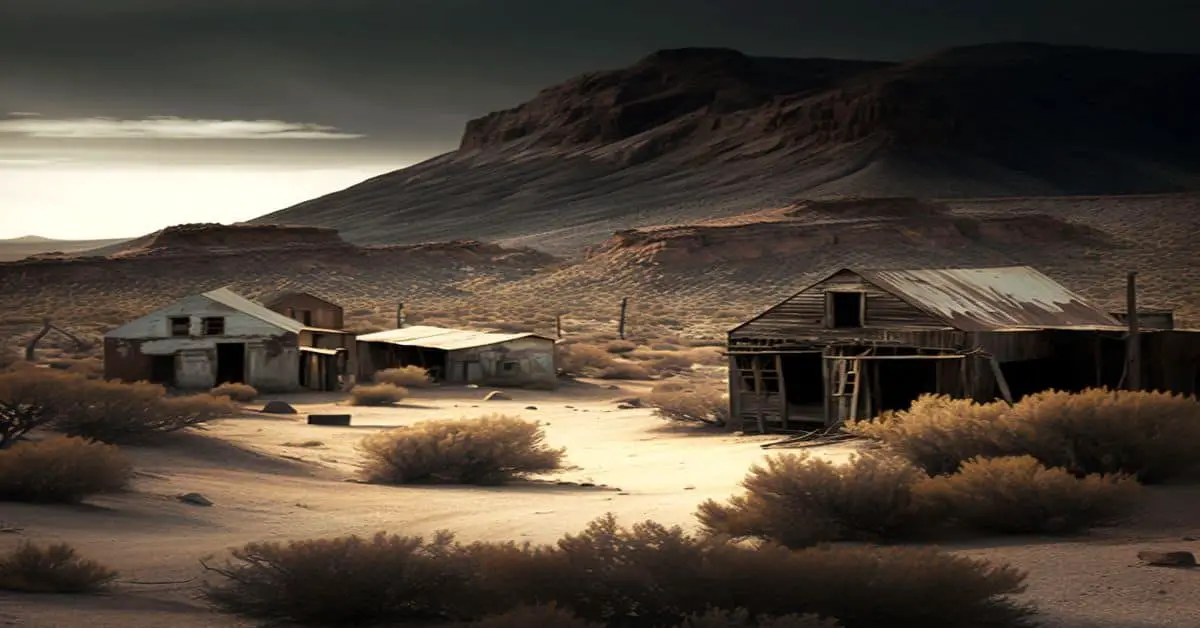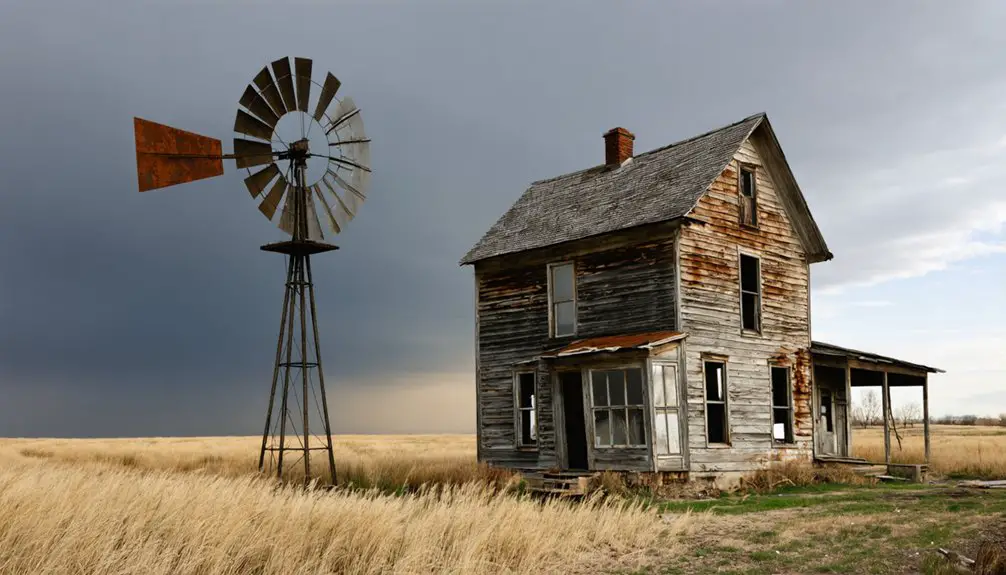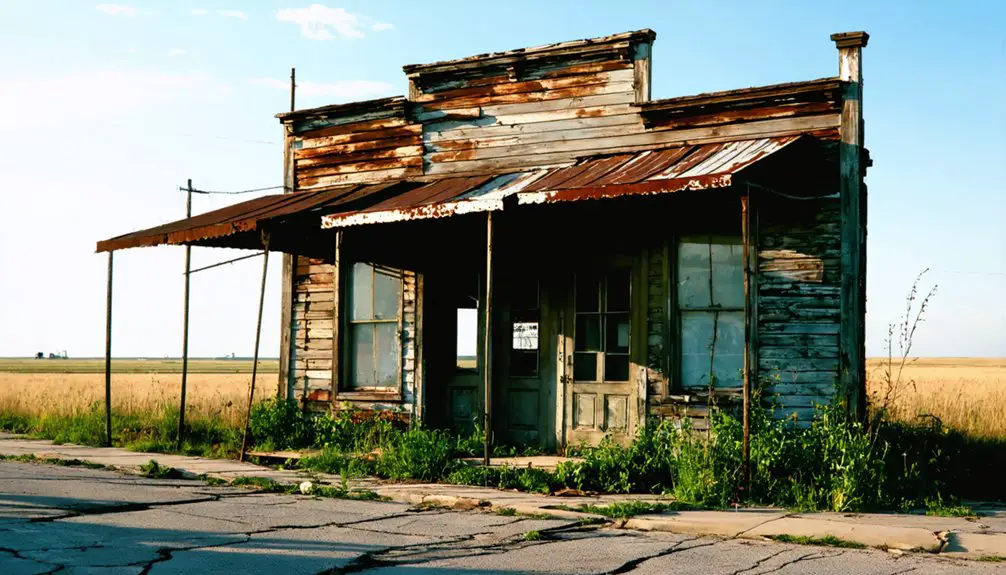You’ll find Dunwell’s remains in Hooker County, Nebraska, where this ghost town once thrived as an agricultural hub in the early 1900s. The community grew around its post office, established in 1889, serving nearly 100 residents who farmed wheat and raised livestock. Life centered on 160-acre homesteads, the general store, and community gatherings until the 1950s rural exodus. The weathered foundations and prairie grass now whisper stories of pioneer dreams and determined settlers.
Key Takeaways
- Dunwell was established as an agricultural community in Hooker County, Nebraska during the late 19th century, initially attracting pioneer settlers.
- The town’s post office operated from 1889 to 1934, marking the community’s peak period with nearly 100 residents.
- Agricultural activities centered around 160-acre homesteads, livestock operations, and railroad access through the Chicago, Burlington and Quincy Railroad.
- Population decline began after 1950, influenced by rural exodus and diminishing railroad services, leading to complete abandonment.
- Dunwell is now classified as a ghost town with no permanent residents, following the closure of the Belmont Tunnel in 1982.
Early Settlement and Post Office Establishment
While the exact founding date remains uncertain, Dunwell emerged as a small agricultural community in Hooker County, Nebraska during the late 19th or early 20th century.
Like many frontier settlements that dotted Nebraska’s vast plains, Dunwell’s history began with hopeful pioneers seeking new opportunities in ranching and farming. Similar to nearby Monowi, the population gradually dwindled over time.
Like many frontier settlements that dotted Nebraska’s vast plains, Dunwell’s history began with hopeful pioneers seeking new opportunities in ranching and farming.
You’ll find Dunwell’s early settlement patterns followed the typical progression of Nebraska’s rural communities. The establishment of a post office marked a significant milestone, serving as the town’s crucial communication hub for over three decades.
This postal station helped cement Dunwell’s position as a recognized community within Hooker County, though the town remained sparsely populated due to its remote location.
Despite limited official records of the original town site, the post office’s presence confirmed Dunwell’s role in the region’s pioneer-era development. For researchers and historians studying Dunwell, precise navigation links to historical records have helped piece together the town’s past.
Life in Dunwell’s Peak Years
During its peak years in the early 20th century, Dunwell bustled with nearly 100 residents who carved out a living through ranching and farming on Nebraska’s expansive plains.
You’d find a tight-knit community where social gatherings at the local general store brought folks together to share news and trade goods. Like many settlements, the town was established near a creek, which ultimately contributed to its eventual downfall. Similar to how Quaker values influenced early pioneers like Dr. John Evans, community events centered around the town’s multi-purpose buildings, where families gathered for education, worship, and celebration.
Life in Dunwell revolved around:
The heartbeat of Dunwell pulsed through its ranches, local gathering spots, and community events that bound neighbors together.
- John Cadman’s original “ranche” and surrounding farmsteads where settlers worked the land
- Local establishments that served as social hubs for sharing frontier challenges and victories
- Regular community gatherings that strengthened bonds between ranching and farming families
Despite limited ethnic diversity and sparse population density, Dunwell’s residents created a self-reliant community built on cooperation and mutual support.
Agricultural Roots and Economic Foundation
If you’d visited Dunwell during its prime, you’d have found a bustling agricultural community where settlers worked 160-acre homesteads growing wheat, corn, and oats in the rich Nebraska soil.
The town’s farmers maintained healthy livestock operations, raising cattle and pigs to complement their crop income, while relying on shared labor during planting and harvest seasons.
Your success as a Dunwell farmer largely depended on your proximity to the railway depot, which determined how efficiently you could transport your grain to market and receive essential farming equipment.
Crop Production and Markets
As settlers established roots in Dunwell during the early 1900s, they faced the challenging task of transforming vast prairie lands into productive farmland through traditional dry farming methods.
You’d find these determined farmers experimenting with crop diversification, growing everything from wheat and corn to rye and flax, adapting to the harsh Plains conditions and market fluctuations. Many farmers, like Nelson Sheffer’s father, established successful farms in nearby valleys despite the wilderness conditions. Early settlers often relied on parched rye as a coffee substitute when supplies were scarce.
Local farmers faced three major challenges:
- Breaking tough prairie soil while managing persistent weed growth
- Battling natural disasters like droughts, grasshopper infestations, and harsh winters
- Steering through unstable markets that often made grain crops profitable only when fed to livestock
Despite these obstacles, Dunwell’s farmers showed remarkable resilience, evolving from subsistence farming to market-oriented production.
Though they’d frequently adjust their crop selections based on economic viability rather than ideal growing conditions.
Livestock Raising Operations
Three pillars of livestock raising formed the economic backbone of early Dunwell: cattle operations, sheep herding, and hog farming. You’d find cattle grazing on vast prairie lands, while sheep dotted the hillsides and hogs provided sustenance for local families.
As livestock trends evolved, the town’s ranchers adapted by integrating mixed farming strategies to weather economic shifts and unpredictable harvests. The introduction of modern mechanization transformed how ranchers managed their livestock operations.
Your ancestors’ success depended on their innovative approach to livestock management. They’d rotate grazing patterns to protect the soil, use crop residues for winter feed, and apply manure to enrich their fields.
The stockyards and related businesses created essential jobs, while livestock sales generated revenue that built roads and community buildings. This agricultural foundation helped Dunwell remain resilient through market fluctuations and challenging times.
Transportation and Trade Routes
The Chicago, Burlington and Quincy Railroad‘s arrival in the late 1880s transformed Dunwell from a livestock outpost into a bustling agricultural hub.
You’d have seen the Belmont Tunnel’s construction nearby opening crucial trade routes that connected your community’s farmers to distant markets.
The transportation evolution hit Dunwell hard as the years passed:
- Rail services dwindled by the 1960s, with passenger trains becoming a memory
- The rise of trucking shifted trade from rails to highways, bypassing your town
- When the Belmont Tunnel closed in 1982, it signaled the final chapter
Construction of the tunnel was a massive undertaking that required two years of labor to complete.
The trade decline accelerated as newer transport routes favored larger towns.
Like the Burlington railroad’s decision to end passenger service in 1969, Dunwell’s transportation lifeline gradually disappeared.
Without the railroad’s lifeline, Dunwell’s stores and post office couldn’t survive, and by 1934, your once-thriving community began fading into history.
Railroad Connections and Transportation

While many Nebraska towns sprouted up directly along major rail lines, Dunwell’s relationship with the railroad proved more nuanced.
You’d find the town positioned strategically between Mullen and Tryon, close enough to benefit from railroad expansion but not directly on the main lines. By 1915, Dunwell had earned its spot on official Nebraska railroad maps, suggesting its role in the region’s transportation infrastructure.
The railroad’s influence reached far beyond the tracks themselves. You could see it in the steady flow of European immigrants settling the area, the movement of agricultural goods to distant markets, and the crucial delivery of mail that kept Dunwell connected from 1900 to 1934. Early settlers recognized that communities relocated to prosper near established railroad routes, though Dunwell managed to maintain its original location.
Though not a railroad town proper, Dunwell’s community relied on nearby rail access for survival and growth.
Population Changes Through the Decades
You’ll find Dunwell’s population reached its peak during the turn of the century, with the town sustaining enough residents between 1890-1920 to support its own post office and basic community services.
The rural exodus that swept through Nebraska’s small towns after 1950 hit Dunwell particularly hard, as families sought opportunities in larger regional centers.
Today’s census records tell a stark story of this once-vibrant community, with Dunwell now classified as a ghost town lacking any permanent residents.
Peak Growth Years 1890-1920
During Dunwell’s formative decades between 1890-1920, population growth closely mirrored the town’s railroad-driven development, starting with an influx of workers who arrived for the railroad tunnel construction in 1888.
The railroad influence shaped strong community dynamics, with families settling around the emerging infrastructure and services.
You’ll find these key milestones marked Dunwell’s peak growth:
- The 1889 post office establishment created the town’s official identity
- Construction of the community hall in 1901 showed a thriving social core
- The railroad tunnel’s completion around 1906 cemented the town’s strategic importance
The period between 1910-1920 likely saw Dunwell’s highest population, supported by both railroad operations and regional agriculture, though exact numbers weren’t recorded in available census data.
Rural Exodus After 1950
As larger cities like Omaha and Lincoln drew Nebraska’s population eastward after 1950, Dunwell’s community fabric began to unravel through a steady exodus of its younger residents.
You’d have seen the changing rural demographics firsthand – fewer children in schoolyards, abandoned farmhouses dotting the landscape, and aging faces at the local market.
The pattern mirrored what was happening across rural Nebraska, where towns watched helplessly as their 20-to-24-year-olds left for college or work, rarely to return.
Urban migration claimed nearly half of this age group every decade. Without young families to sustain it, Dunwell’s liveliness faded.
Modern Census Data Trends
While Dunwell’s early years showed promise with Hooker County’s population soaring to 1,378 residents by 1920, the town’s demographic story would become one of steady decline.
Census accuracy shows you’d find only 686 people in the entire county by 2022, revealing the stark reality of demographic shifts that have transformed this once-thriving frontier community.
- The 1970s marked a turning point, with population dropping to 939 – a clear sign of the region’s changing fortunes.
- You’ll notice a brief uptick to 990 residents in 1980, but that hope was short-lived.
- Since 1990, each decade has seen fewer neighbors calling this land home, with numbers falling below 800.
These patterns paint a picture of a community that’s gradually disappeared into the Nebraska prairie.
Community Infrastructure and Services
From its establishment in 1900 until the mid-1930s, Dunwell’s modest infrastructure centered around its post office, which served as the community’s crucial communication hub.
You’d have found this essential postal service operating daily, facilitating community engagement through letters and packages while connecting residents to the wider world for over three decades.
The town’s limited infrastructure reflected its rural character.
You wouldn’t have seen railroad tracks or paved roads – just dirt and gravel paths connecting you to nearby Mullen and Tryon.
Without documented evidence of stores, schools, or utilities, daily life likely revolved around self-sufficiency.
You’d have drawn water from private wells, relied on kerosene lamps for light, and traveled to neighboring towns for supplies that weren’t available in Dunwell itself.
The Path to Abandonment
During the early decades of the 1900s, Dunwell’s journey toward abandonment began with the slow erosion of its economic foundations.
You’ll recognize the familiar pattern of economic shifts that swept through rural Nebraska, as essential industries diminished and younger residents sought opportunities elsewhere.
- The town’s demographic shifts accelerated during the Great Depression, with the 1934 closure of the post office marking a turning point in Dunwell’s decline.
- Your ancestors might’ve witnessed how changes in transportation routes bypassed their community, redirecting commerce toward better-connected towns.
- You’d have seen how environmental challenges and unstable crop prices made it increasingly difficult for local farmers to sustain their way of life.
The town’s fate was sealed as these forces combined, leading families to reluctantly bid farewell to their prairie home.
Legacy and Historical Significance
As a tribute to Nebraska’s pioneer spirit, Dunwell’s legacy endures through its role in shaping Hooker County’s early development.
You’ll find traces of community resilience in the town’s 34-year post office operation, which served as a crucial hub connecting residents to the wider world from 1900 to 1934.
While the buildings may be gone, Dunwell’s cultural identity lives on through local histories and archival records.
The town’s story mirrors countless other rural settlements that flourished during America’s westward expansion, offering valuable insights into the challenges faced by pioneer communities.
Today, you can explore Dunwell’s heritage as part of Nebraska’s ghost town tourism, where its history teaches valuable lessons about economic changes, rural adaptation, and the transient nature of frontier settlements.
Frequently Asked Questions
What Caused the Last Family to Leave Dunwell?
You’ll find that the final family departed when their economic decline became unbearable, as family dynamics shifted with younger members seeking opportunities elsewhere, leaving aging parents unable to sustain themselves alone.
Were There Any Notable Crimes or Mysteries in Dunwell’s History?
You won’t find any unsolved mysteries or notable crime history here – historical records and local documentation show a peaceful community that simply faded away due to economic changes between 1900-1934.
What Buildings or Structures Still Remain at the Dunwell Site Today?
You’ll find only a handful of deteriorating abandoned structures hidden among overgrown trees today – mostly collapsed residential ruins and old coal shaft remains, with nature steadily reclaiming these forgotten pieces of history.
Did Any Famous People Ever Visit or Live in Dunwell?
You won’t find any famous visitors or notable residents in the town’s history – historical records and local archives don’t show evidence of any celebrated figures ever calling this prairie community home.
What Was the Average Property Value in Dunwell During Its Peak?
Like a fading photograph, real estate values back then were modest at best. You’d likely have found lots selling between $50-$150, based on historical comparisons with similar rural communities of that era.
References
- https://kids.kiddle.co/Dunwell
- https://en.wikipedia.org/wiki/Dunwell
- https://www.youtube.com/watch?v=l3s2qhSxis8
- https://visitnebraska.com/trip-idea/explore-7-authentic-ghost-towns-nebraska
- https://www.familysearch.org/en/wiki/Hooker_County
- https://history.nebraska.gov/wp-content/uploads/2017/12/doc_publications_NH1937GhostTowns.pdf
- https://www.youtube.com/watch?v=redtU6GT-BY
- https://llcgs.info/cpage.php?pt=54
- http://catherinescorner.net/?m
- https://www.youtube.com/watch?v=PAm9BHIpjL0



